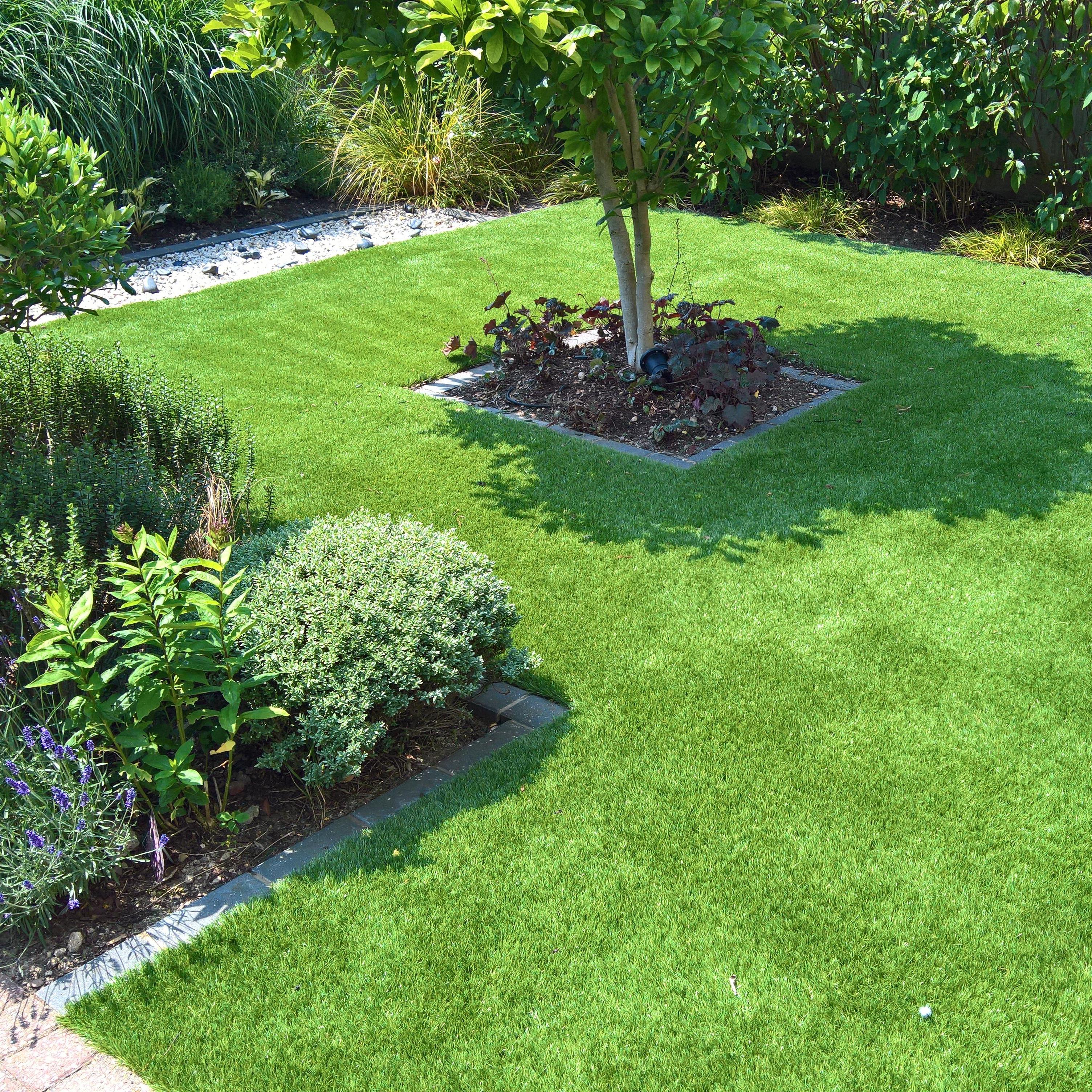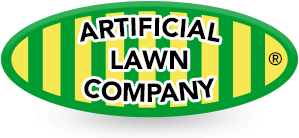ARTIFICIAL TURF
Artificial turf is becoming more popular than ever before, and it continues to be used more and more in people’s homes, by schools, in offices
It is no secret that it took a little while for artificial turf to take off; too many memories of playing football on sub-standard surfaces and scratchy material. As the concept and the
Why is artificial grass so popular?
There are several reasons people are choosing to switch to artificial turf, and here are a few of the most common:
- Less time spent maintaining the garden
- A healthy, luscious lawn all year round
- Money saved on water bills, by eliminating the need to water the garden
- A safer place for children to play sport
- A more
pet friendly option - A practical way to prevent
children bringing grass and mud into the house
With warmer weather and increased periods of heavy rainfall on the long-term weather forecast, the popularity of artificial lawns is expected to skyrocket.

There are three aspects to calculating the cost of replacing your lawn with artificial turf:
1)Â Â Â Â Â Preparing your lawn
2)Â Â Â Â Â Purchasing artificial grass
3)Â Â Â Â Â The cost of installation
We go into more detail, dissecting the costs involved with installing artificial turf in our ‘How Much Does Artificial Grass Cost’ guide, but here’s an overview.
Preparing Your Lawn
We’ll cover the ins and outs of preparing your lawn for artificial turf when we discuss the installation process, but in terms ofÂ
There are a few costs that will be involved, regardless of which option you choose. Skip hire will most likely be necessary if you’re going to do a thorough job, and if you are taking grass out, you’ll need to replace it with soil to level the lawn before installation. Skip hire will cost approximately £220, andÂ
To keep the numbers simple, we’ll base the following costs on a 10m2 garden, which is a little smaller than the average garden in the UK, but it’s pretty close.
Assuming it’s not possible to get a digger around to the garden, which in many cases it isn’t, it would likely take a team of two a day to clear the garden. You might find that the process could be completed quicker if your lawn is made up of ideal soil. However, in some cases, the soil can be particularly hard or full of stones, so the safer estimate is for a full day – which will cost you around £350 - £400.
As mentioned previously, you can save this cost by doing it yourself – but expect it to take longer than a couple of days, and you might still want to rent some tools to make the process a little easier.
Purchasing Artificial Grass
You can purchase cheap artificial grass for £10 per m2 or sometimes even less – but when you’re investing inÂ
You’re not likely to find quality artificial turf for much less than £15 per m2. For example, prices on our website start at £15.95 and go up to £25.95.
It’s not wise to make your purchasing decision based on price alone though; you need to ensure you choose the right artificial turf for your needs.
The Cost of Installation
Around 50% of people try to lay artificial lawn themselves, and there are some fantastic guides online that walk you through the process step by step.
We’d always recommend using a specialist installer to ensure that the result is a perfectly level lawn with a high-quality finish that will last for years and years.
Installation costs vary significantly, but inÂ
This means that the total cost of preparing the lawn, purchasing quality artificial turf and installing it in a 10m2 garden would be between £1,000 and £1,500.
Depending on how you choose to install your artificial lawn, here’s a breakdown of estimated costs, based on a 10m2 lawn:
Skip Hire:            £220
Top Soil:              £30
(1 tonne)
Labour:                £350
(clear garden)
Artificial Grass: £200
(at £20 per m2)
Installation:       £450
(at £45 per m2)
=====================
Total Cost:         £1250
=====================
Â
All these numbers are estimated and rely on a lot of assumptions, so shouldÂ
It is vital that you select the right artificial turf for your needs. Artificial grass has become much more sophisticated and there are some varieties that are perfect for pets, some that work well if you have children who will be running over it all day, and some that are more forÂ
1)Â Â Â Â Â Pile Height
This refers to the length of the blades of grass. Pile height varies significantly in different artificial grasses. As a rule, longer blades of grass lookÂ
All the different artificial turfs we supply are designed for longevity and range from 15mm pile height for ex CruftsÂ
Artificial turf suppliers will always state the pile height of their turf, so this should be easy to determine when shopping.
2)Â Â Â Â Â Durability
No one buys artificial turf with the intention that it won’t be durable; in some cases though, durability is more important.
As long as you don’t purchase very cheap artificial turf, and you buy from a reputable provider, your grass will be durable enough to last many years if maintained properly. However, you need to question how much traffic your lawn will get to determine how durable your grass needs to be. If your lawn is purely for aesthetic purposes and just needs to look nice, then you’ll find most artificial grass is suitable. However, if you need a lawn that’s going to be played on by children, or used by pets, then you might need to select your artificial grass a bit more carefully.
3)Â Â Â Â Â Quality
It goes without saying that you want a high-quality artificial turf. There are a few tricks that can be used to determine the quality of artificial grass, but by far the most effective and important is to request a sample and check for yourself.
If an artificial grass supplier doesn’t offer samples – we would be very wary of using them.
4)Â Â Â Â Â Colour
Synthetic grass comes in variousÂ
The main thing to look for if your main criteria is a ‘natural colour’ is the number of colours used in the artificial grass. Natural grass isn’t all one colour; it is a mix of greens and yellows.
Cheaper artificial grass tends to be all one colour and a consistent length, while better quality varieties are a mix of three or more colours and have blades of slightly differing lengths.
5)Â Â Â Â Â Pile Type
The pile type refers to the ‘style’ of the blades of grass.
As mentioned in the previous section, cheaper varieties will have one consistent pile type;Â
Our personal preference is for a straight and curled pile type; however, it really is a matter of preference – Crufts, for example, use mainly curled pile types.
If you’re looking for a guide on how to install artificial grass, we’ve got a step by step manual available.
As an overview, here’s a breakdown of the process and some of our top tips.
1)Â Â Â Â Â Prepare your lawn
Let’s begin with a top tip – hire a skip! You’re going to have far too much turf and soil to dispose of to rely on your Garden Waste bin alone, and you will probably spend more in petrol on trips to the tip than you would on skip hire.
Lawn preparation involves digging up existingÂ
2)Â Â Â Â Â Order your artificial turf
Find an artificial grass supplier, choose the grass that is right for you, and order.
3)Â Â Â Â Â Installation
We recommend that you lay geotextile fabric on top of your layer of sand. This will prevent any weed growth through the surface’s drainage holes, which might damage your lawn in the long term.
It is
If you are going to need to join sections of artificial grass together, make sure you lay the turf with the pile running in the same direction; otherwise, it will be obvious where the joins are.
Then scatter a layer of kiln dried sand to ensure the grass remains in position. Brush as you go, rather than after laying a full layer of sand, and brush the sand in the direction of the pile. It is vital that this is done immediately after the laying of the sand, while the surface and weather are both dry.
We’ve simplified the process as much as possible and you’d still be forgiven for thinking that it sounds like quite a lot of work. If you are used to manual jobs like this, it’s not too bad, but if you are a novice, it can beÂ
One of the benefits of artificial turf is that it needs much less maintenance than natural grass – that being said, to prolong its life and to keep it looking lush and natural, there are some steps you’ll want to follow to maintain grass quality:
Â
-Â Â Â Â Â Â Â Â Â Brush frequently to remove soil, dirt or debris and keep the pile looking fresh
-Â Â Â Â Â Â Â Â Â Wash the lawn shortly after installation to remove dust, and then wash as and when needed. Never use a jet or pressure washer on your artificial grass
-Â Â Â Â Â Â Â Â Â Occasionally loosen the sand on the surface with a spring rake
-         The sand layer shouldn’t be overly visible, but it is worth checking every few months to see if it has been dispersed. If so, top up with a little more
-Â Â Â Â Â Â Â Â Â Do not place hot BBQs directly on the grass, and avoid stubbing out cigarettes on artificial grass
-Â Â Â Â Â Â Â Â Â In the case of snow, leave it to melt rather than using chemical de-icers
Â
Artificial grass can be a low maintenance and visually attractive solution for your lawn. While it is less maintenance in the long run, and it often requires less expenditure as there’s no need for weeding, seeding or mowing, it does involve an initial investment.
If you are considering artificial turf for your lawn, remember to budget, choose the right turf for your needs, and consider the maintenance that is required.
